by Bridget
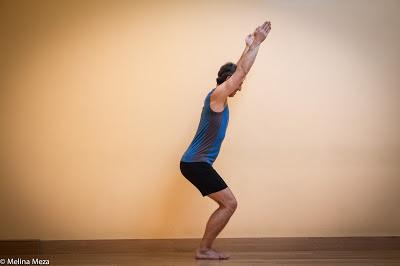
I spent 10 years of my childhood in a small retirement village in Wisconsin. My next-door neighbors Walter and Evelyn were my favorites to visit. They were in their late-70’s and early 80’s while we lived there, and I would go over and watch television with them after school (we didn’t have a television at my house). I was so fascinated by Walter’s ability to take his teeth out (dentures), and Evelyn’s special chair (it was some early version of a Lazy Boy Power Lift), which stood her up when she needed to go to the kitchen. Her knees were in bad shape from a lifetime of standing for her work at a restaurant. Thinking back on it now, I realize that part of the problem with her knee pain and inability to stand came from weakness in her legs, which she had lost gradually over time. Maintaining strength in our legs is an important part of healthy aging, and one we can begin working on at any time.
What I particularly like about Powerful pose (Utkatasana) for strength building is its utility. It’s a powerful strengthener for the legs, but also works the back body. Working the large muscles in the legs (mainly the quadriceps at the front of the thigh) really gets blood flowing, warming the body. The work in both the back body and the legs are so important for continuing to be able to get up out of a chair as we age. The beauty of Powerful pose is the number of variations available to make it accessible, no matter what is going on for you. I’m going to go through a couple of variations here, then talk a little bit about moving through the pose with intention.
Variations of Powerful Pose
1. Buttocks on Wall. If maintaining balance is an issue for you, or if your legs feel a bit wobbly in the classic pose, placing the buttocks on the wall will give you stability and take some of the weight out of the pose. Start close to the wall and get your backside grounded, then bend your knees and slide down the wall a little bit before you walk your feet out (usually about 12-18 inches away from the wall). Position your feet so they are hips-width apart and align your knees so the are directly above the middle of your feet.
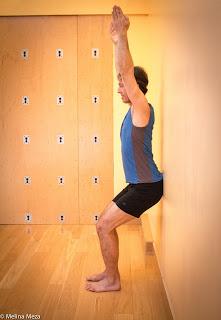
2. Hands on Hips. If your shoulders or back body feel weak, or if you’re dealing with an injury there, you can place your hands on your hips. This takes the work, or the pain, of lifting your arms, out of the equation and allows you to focus on the work in your legs and the lengthening of your spine. You can place hands on your hips in any of the variations, or even briefly for a rest when you’re holding the pose for a longer time.
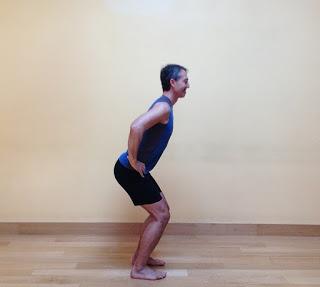
3. Block Between Legs. To gain awareness of and increase the strengthening in your legs and abdomen, try using a block between your upper thighs. Starting in Mountain pose, place the block midway between your knees and your pelvis, on either the narrowest or middle width (the middle width is better if your hips are wider). Press your thighs into the block and imagine you are pressing the block through your thighs toward the wall behind you—this is where the lower abdominals begin to be engaged. Then come into the pose maintaining this work.
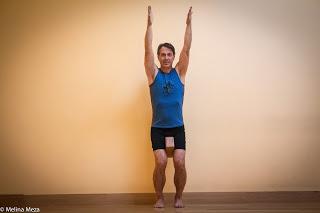
4. Block Between Hands. If you want to increase the strengthening in your upper body, try using a block between your hands. Starting in Mountain pose, hold the block the widest way between the palms of the hands. Then, reach your straight arms forward to find the work as you press your hands into the block, like you’re trying to crush it. Finally, relax the top shoulders and sides of the neck before you lift your arms and move into the pose.
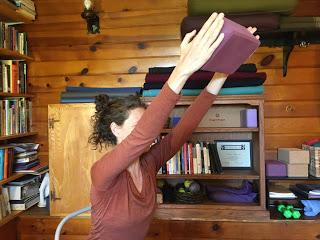
5. Using a Chair. For those who want to work on the actions required for sitting down and getting up from a chair, as long as your knees will allow it, this version will strengthen your legs in just the right way for sitting and standing up from a chair. Start by sitting at the front edge of the chair. Slide your feet in toward the chair as far as they can go without your heels coming up off the floor. Sit up tall to find the length in the spine so you can maintain that as you hinge forward from your hips. Press your feet into the floor and first try just making your buttocks light on the chair, an action that is more difficult than it sounds, so just try to hold it for a breath before releasing back to the chair with control. This gets you used to the idea of standing without using momentum. Next, use your leg muscles to increase the amount of lift away from the chair one inch, (lift off the chair, then lower back down with control) then 4 inches, then 8 inches, until you come to standing. Then you can do the whole sitting/standing a few times. Send your hips back and use the strength of your legs to lower yourself down to the chair, setting down silently and with control, then lift again with control (try not to use momentum by leaning quickly forward).
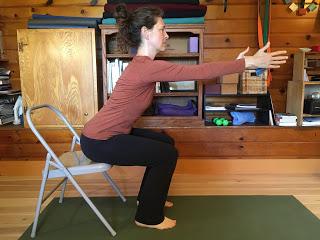

Working in the Poses
It's easy in Powerful pose to let gravity take over, so finding those places where your body is trying to catch a little moment of rest is where you'll find the powerful strengthening that's possible in this pose. The main thing is to not be in a hurry to arrive in the pose (whatever version you are doing). Take your time arranging each part of the pose, and don't allow the automatic positioning to take over.
So stand in Mountain pose and find your feet on the ground. Lift your toes and spread them. Notice how the weight is distributed in each foot and try to make it even—from the front to the back of each foot as well as from side to side. Keep some weight in the front of your feet rather than having all your weight dropping onto your heels. From there, press your feet into the floor and lift your legs toward your pelvis, then lift your spine and make yourself a little bit taller.
Next, take your arms forward, palms facing one another, and relax the tops of your shoulders and the sides of your neck. Then notice the length of your spine and set an intention to maintain that length as you start to move into the pose. For this next step, I like to imagine that I have two partners, each with a strap, who are helping me. My first partner is in front of me with the strap around the back of my knees. The second partner is behind me with a strap at the front hip crease. As I begin to lift my arms, they both gently pull on their straps, resulting in an even distribution of the bend in both the knees and the hips.
Once you arrive in the pose that works for your body, check in with your feet. Is the weight still even? Notice your knees. Are they tracking over the middle toe or are they drooping in toward one another? Notice your shoulders. Are they trying to help with the lift of the arms? Can you soften there by letting the spine rest back between the shoulder blades?
Hold the pose for as long as you can maintain the strength in it. As soon as you feel your body sagging or finding places to rest, it's time to come out, take a rest, reset, then try it again.
Nina says more about timing and repetitions in her post Techniques for Strength Building with Yoga if you want to read more on this topic.
Find information on Bridget's current classes here.
Subscribe to Yoga for Healthy Aging by Email ° Follow Yoga for Healthy Aging on Facebook ° To order Yoga for Healthy Aging: A Guide to Lifelong Well-Being, go to Amazon, Shambhala, Indie Bound or your local bookstore.

